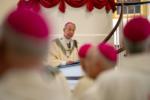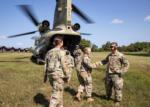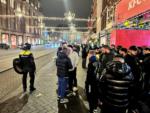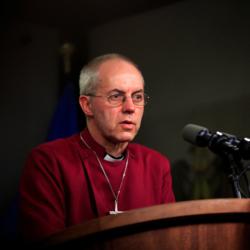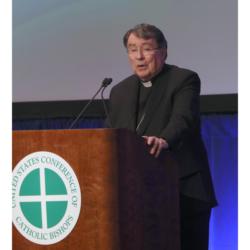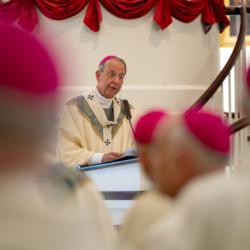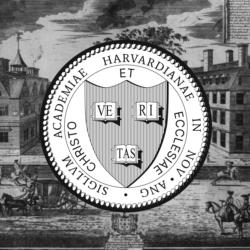So, you need a coat of arms?
Tucked away in the whirlwind of activity surrounding the appointment of a priest to be a bishop in the Church is this strange piece of advice to the newly appointed bishop, "Oh, and by the way, you're going to need a coat of arms." With those few words a man who now must contend with a change in rank, a change in ministry, possibly a change in location or residence, as well as the necessity of obtaining several new pieces of wardrobe and liturgical pontifical insignia, is also introduced to something which, up until that time, he has most likely never considered even for a moment: heraldry.
That is, the science and art of providing a personal means of identification in accord with an ancient practice that has its origins in 12th-century Europe and with, of all things, going into battle. Heraldry, the collective name for the designing, creating, and displaying the work of heralds, namely regulating coats of arms, started in the 1100s with a very practical purpose. While encased in a full suit of armor it was difficult to tell friend from foe on the battlefield. The devising of personal emblems and then displaying those emblems on a shield, or a banner, or worn as a surcoat over the armor (which is, by the way, where we get the term "coat of arms"), or even emblazoned on a comparison (the large covering for a horse in battle) all made it much easier to see who was who in the confusion of a battle.
But what has something so associated with fighting and to do with a clergyman? Well, I think if you asked just about any priest, he will tell you that his life and ministry can often be likened to a battle, albeit a spiritual battle rather than a military engagement. Nevertheless, it seems odd to many to associate something so martial as a coat of arms with the Church and her mission to bring the Gospel to the world. People often ask how that happened? The answer is simple: seals. This brings us to what might be considered the first myth about a bishop's coat of arms. Frequently, it will be said, especially to a newly appointed bishop, that, "All bishops must have a coat of arms." But, in fact, that isn't true. What canon law requires is that all bishops, as well as institutions and corporate bodies in the Church, must have a seal to authenticate documents. However, there is no rule whatsoever dictating that such seals must be armorial in design. Rather, over the centuries, it has merely become customary to use a coat of arms on an ecclesiastical seal. After all, a coat of arms is first and last a means of identification, so it fits very well on a seal used to authenticate documents in the name of an individual or corporate body.
Very shortly after heraldry began to develop, it made its way into use by the Church as prelates and other churchmen, religious communities such as abbeys, and parishes and dioceses began to replace the older versions of seals, which usually depicted the owner's patron saint, or the patron saint of the place, with the armorial bearings of the bishop, abbot, diocese, abbey, or parish in question. This leads to the second myth about ecclesiastical heraldry and about heraldry in general. Namely, that coats of arms belong to royalty and nobility and must be granted by a king, and that for others to use them is a pretension that is incongruous with the clerical state. Nothing could be farther from the truth. As early as the 13th century -- a mere 100 years after the development of heraldry in general -- coats of arms were being assumed, that is, devised and adopted as well as being granted to people by a higher authority in the highly structured hierarchy of feudal society. In other words, coats of arms weren't just for kings and nobles. They were used by the clergy as well, some of whom had quite humble origins. There is evidence to suggest that coats of arms were used even by those of the "peasant class" as early as the 1300s. It is true that having a coat of arms is something that is supposed to be for those considered "deserving" of an honor. In the Church, ordination or the profession of religious vows for those who are not ordained is something that renders someone worthy. Indeed, monks, nuns, and abbesses have long made use of heraldry.
So, since a bishop needs to have a seal by canon law, and since, for several hundred years, it has been the custom to have a coat of arms to place upon such a seal, where does a new bishop go to obtain a coat of arms? That's where I, and others like me, come in. Archbishop Henning was born and raised on Long Island, New York, and so was I. In fact, we have been acquainted for quite some time. We both attended Chaminade High School in Mineola, N.Y., and graduated together in the Class of 1982. He remained on Long Island in the Diocese of Rockville Centre, whereas my life took me to several different places before I ended up in the Diocese of Metuchen, New Jersey, where I continue to serve today. While the archbishop and I were not close friends, having both entered the priesthood, we were certainly aware of each other and occasionally crossed paths. At the time he was appointed Auxiliary Bishop of Rockville Centre in 2018, he contacted me because someone had uttered those words to him, "Oh, and by the way, you're going to need a coat of arms."
Ever since boyhood, I had been interested in coats of arms. My interest went beyond merely enjoying the sight of them. I wanted to know more. That was a difficult task, however, since, unlike other countries where heraldry abounds and has a rich and long history, the United States is a bit light on heraldic displays in our culture. However, one day, I chanced upon a biography of Pope St. Paul VI, who was still alive and reigning as pope at the time. The book contained an image of the pope's coat of arms. I hadn't realized that a pope would have a coat of arms. My older brother explained to me that every pope has a coat of arms and that, in fact, every bishop has a coat of arms. It was then that I realized, like the proverbial lightbulb going on over my head, that heraldry was alive and well in the Catholic Church, regardless of what country you're from! In fact, in today's world, the Catholic Church is one of the greatest and most consistent users of heraldry in the world.
I still only had a rudimentary knowledge of the subject and had pored over every book I could find in the public library. The 1978 "Year of Three Popes" was the occasion for the publication of a book that became essential reading entitled, "Heraldry in the Catholic Church" by Archbishop Bruno Heim. He was a papal diplomat who had been private secretary to Pope St. John XXIII at the apostolic nunciature in Paris and who had concluded his own diplomatic career as the first pro-nuncio to Great Britain since the Reformation. It was, and remains, the quintessential guide to Catholic ecclesiastical heraldry. When I attended St. Francis University in Loretto, Penn., I discovered they had an extensive number of books on heraldry in its library and my study of the topic continued to grow and deepen. It was in 1987 when I was attending St. Vincent Seminary in Latrobe, Penn., that the diocese in which the seminary was located -- Greensburg -- received a new bishop. His coat of arms had been designed by a professor at Duquesne University in Pittsburgh and the artwork had been rendered by none other than Archbishop Heim himself!
I contacted the professor, the late Dr. Geza Grosschmid, and went to see him. He was a friend and frequent collaborator with Archbishop Heim and I wanted to ask him if there were some course of study I could undertake to learn more about heraldry. Sadly, he informed me that there wasn't but thus began a relationship that lasted until his untimely death in 1992. Dr. Grosschmid became my tutor and mentor in heraldic design, critiquing the various coats of arms I was able to design for different clients. I learned by doing but also never stopped reading and researching. Heraldry became and has remained my passion and avocation for the past 39 years.
I was delighted with the task of designing a new coat of arms for then-Bishop Henning and set to work right away. Bishop Henning invited me to his episcopal ordination, and I gladly accepted. It was rather gratifying to see my handiwork in the program for the liturgy and to be able to concelebrate the Mass with my old high school classmate. He even managed to surprise me. Near the end of the Mass, as he was making some prepared remarks and expressing thanks to those who had assisted him, he publicly thanked me for helping him prepare his coat of arms. After the liturgy at the reception, I had the chance to thank him for that. He seemed surprised and asked, "Well, isn't that what's supposed to be done?" I then informed him that in all the years I had been designing coats of arms for bishops, and there have been quite a few, no bishop had ever thanked me in public for my work; he had been the first. Later, when he was appointed coadjutor of Providence, I reached out to him to inform him that there was no need to modify his existing coat of arms as coadjutor. However, once he succeeded to the See of Providence, it would be necessary to combine his personal coat of arms side-by-side on the same shield with those of the Diocese of Providence. This method of marshaling two separate coats of arms is called "impaling." It's a form of combining two coats of arms that originally developed in the world of heraldry to display the coats of arms of two armigerous people who had gotten married. The Church employs this method as a further symbol, along with the episcopal ring, that the bishop is "wedded to" his diocese.
Little did I imagine that a mere 15 months after he became Bishop of Providence in his own right, Bishop Henning would be in touch with me again to, once again, make modifications to his coat of arms as he had been appointed Archbishop of Boston! I once again set to the task with great delight. I did my final year of study and priestly formation in the Archdiocese of Boston, at Pope St. John XXIII National Seminary in Weston. I've always had a great affection for the archdiocese, so I was particularly happy to be helping out an old friend as he prepared for new ministry in a place I had come to know and love so well.
I have to say that Archbishop Henning has always been a most agreeable client to work with through the process of designing a coat of arms. He's genuinely interested in the topic and was very "hands on" throughout to ensure that what we ended up with was not only to his liking but was also heraldically correct. It all began with a conversation that grew into several such talks between us. I then came up with an initial proposal and we began the process together of "tweaking" the design until we reached a mutually agreed upon result. Heraldry is about symbolism. It's not about graphically depicting things realistically so such things as a purple tiger, or a striped apple tree are not only possible in heraldry but appear, perhaps, more frequently than one might imagine. In addition, a coat of arms is not a curriculum vitae -- CV -- in pictures. It's not a pictorial homily, nor a catechetical tool. Rather, a coat of arms has one purpose: to identify the bearer of the coat of arms. They need to be clear, and simple, employing as few elements as possible with as few color combinations as possible. Remember, this started out to identify friends and enemies in battle and that was frequently done from quite a distance. That's not a time to muddy the waters with many symbols or colors that run together. Good heraldry is bold and as simple as possible.
The color palette is limited because, in the Middle Ages, the ability to produce different colors for artistic needs was also limited. Coats of arms employ only five possible colors: red, green, blue, violet, and black. They make use of two metals: gold (usually depicted as yellow) and silver (usually depicted as white). One cardinal rule is that you may not place a color on a color or a metal on a metal. No blue birds on a red field are allowed because the color contrast is not great enough. All too often, it is tempting for a new armiger to want to include as many symbols (called "charges" in heraldry) as possible. They may want to include every aspect of their lives and interests. However, that's a recipe for disaster. The goal is to use as few symbols as possible and the best situation is one where a single charge may symbolize or allude to several things at once. When I'm working with a new client who has a long wish list of things to be symbolized in the coat of arms, perhaps 10 or 12 items, I always ask "Could you place the list in order of importance" ... and then we use the top three only.
In Archbishop Henning's case, he made my task much easier. From the outset, his primary goal was to come up with a design that evokes his birthplace, his ministry, and his personal devotion. The shield employs the colors red, white, and blue, which are the national colors of the United States. In the center of the field is a single charge of an escallop shell. Both the blue background and the shell allude to the sea as evoking his own background and the shell is also borrowed from the coat of arms of the Diocese of Rockville Centre, the diocese in which he was born and raised and which he served as a priest and a bishop. Additionally, this same field of blue can now also be seen to allude to the blue field of the coat of arms of the Diocese of Providence, where he served as coadjutor bishop and later diocesan bishop. The arms of Providence are very simple, depicting three crosses moline (the ends of the arms circling back in the form of an anchor). The blue color represents the sea, for the "Ocean State," and the anchors are a symbol used by the state and evoke its motto: "Hope." The blue background also evokes the bishop's devotion to the Blessed Virgin Mary and his years of service as a Professor and Rector at the Seminary of the Immaculate Conception in Huntington, N.Y.
The coat of arms of the See of Rockville Centre uses the gold and blue borrowed from the arms of King William III of the House of Nassau and on the arms which the county of Suffolk in England has used at times. These symbolize Nassau and Suffolk Counties on Long Island, which comprise the territory of the diocese. The division of the field into two colors is accomplished by the heraldic saltire, or "X" shape, which forms the Greek letter Chi, the initial letter of Christ in that language.
Three of the four partitions formed by the saltire contain escallop shells because the native peoples of the Island called it "Island of Shells." Surrounding the perimeter of the field is a wavy silver bordure symbolizing water and, surrounding, as it does, the other charges, signifies the insular nature of the diocese.
The fourth partition of the field contains a lamb's head, the symbol of St. Agnes, the titular of the diocesan cathedral. The black roundel in the center of the shield contains three stones or rocks borrowed from the coat of arms of Pope Pius XII, who established the diocese in 1957. The roundel is black to represent the marshes, which recalled to the Dutch their homeland in Breuckelen in the Province of Utrecht. The Dutch who settled Brooklyn at first called it "Breuck-Landt," meaning "broken land," or "marshland."
The shell recalls the archbishop's heritage in the Diocese of Brooklyn, whose patron is St. James. Archbishop Henning's episcopal ordination took place on the eve of the feast of St. James. In concert with the bishop's motto, "Put Out Into The Deep," the shell is a traditional symbol of baptism and pilgrimage. It is in the depths of these waters that Christians find their salvation in Jesus Christ.
The white wavy line surrounding the blue field is similarly taken from the arms of Rockville Centre and it alludes to that diocese's location on Long Island, NY. Furthermore, it indicates the sea as the place where the barque of St. Peter, an image used to evoke the Church, is located.
The red wavy portion of the border evokes the bishop's devotion to the Most Sacred Heart of Jesus and his service as the director of the Sacred Heart Institute for the Ongoing Formation of the Catholic Clergy.
So, we can easily see that each of the elements in the archbishop's coat of arms has multiple meanings, yet the overall design is remarkably simple. That's the mark of good heraldic design. There is a lot symbolized but it's not an overcrowded design. In addition, it harmonizes well with the beautifully designed coat of arms of the Archdiocese of Boston. There was no coat of arms for the archdiocese until the tenure of William Henry Cardinal O'Connell (1907-1944). When it was devised, it was a much more simplified design than the one that we see today. The cross in the coat of arms was a simple Latin cross without decorated ends and the triple mount was below it alone without any wavy lines to suggest water. During the tenure of O'Connell's successor, Richard Cardinal Cushing (1944-1970), the arms were slightly modified to the way they appear today by Dom Wilfred Bayne, OSB, a monk of Portsmouth Abbey.
They are composed of a blue field, on which are placed a gold (yellow) cross fleuretty, that is a Latin cross the arms of which are decorated on the ends with fleurs-de-lis. This is in honor of the titular of the cathedral, the Holy Cross, as well as the first bishop of Boston, John Cheverus, being from France. The cross is above a gold (yellow) mound composed of three smaller hills as a reference to Boston's original name: Trimountaine, which is, itself, a reference to the three hills on which the city is said to have been built. At the bottom, the five wavy lines of blue and silver (white), which are sometimes erroneously depicted as eight lines rather than the original five, alludes to Boston being a port city and that it is populated by people who arrived here from across the sea.
So much for what is on the shield. The Church does not overly regulate the use of heraldry. This is partly because several countries in the world, such as England and Canada, have state-sponsored heraldic authorities of their own and the Church does not wish to infringe on the rights of those local authorities. Rather, the few regulations existing in the form of papal instructions or instructions from dicasteries of the Roman Curia primarily concern themselves with what is around the shield rather than what is on it. These external ornaments indicate the rank of the bearer and have developed over time, many as recently as the 20th century. The shield is ensigned, first and foremost, with an archiepiscopal cross standing vertically behind it.
Such a cross is not to be confused, as it often is, with the processional cross used for liturgical celebrations. In the first place, the liturgical processional cross is usually a crucifix, bearing the image of the crucified Lord. The archiepiscopal or episcopal cross is never depicted as a crucifix. In addition, the archiepiscopal cross is a heraldic emblem, which, like other such emblems, has its origin rooted in history, as an object that was actually used at one time, but which no longer is. In former times, a metropolitan archbishop had a cross mounted on a pole, also usually a crucifix, which was always to be carried immediately in front of him, with the corpus facing them, at all public functions. In other words, in addition to a processional cross at the front of the procession, there was a second cross at the rear of the procession immediately in front of the archbishop. That is why today -- when such archiepiscopal crosses as a sign of the archiepiscopal dignity are no longer used practically -- there is a rubric in the Roman Missal that a liturgical procession is only to have one cross in it. Eventually, these metropolitan crosses, used only by metropolitan archbishops, began to be adopted by all bishops and so it became a symbol of the episcopal dignity in general.
Over the course of the centuries, the use of an actual cross carried immediately in front of a bishop or archbishop fell out of use. However, having already been adopted as a heraldic symbol, it remained in use as such. In fact, the episcopal or archiepiscopal cross standing behind the shield is considered the symbol of the coat of arms of a bishop or archbishop. It is, indeed, the only essential heraldic ornament denoting that the coat of arms belongs to a bishop or archbishop. Over time, and in an era when the elaborate galero was not universally employed yet, metropolitan archbishops desired to find a way to differentiate their archiepiscopal cross from the simple episcopal cross. This they accomplished by adding a second horizontal bar to their crosses while bishops used a cross with only one horizontal bar. This is how the episcopal and archiepiscopal crosses developed into the form they have now as an exclusively heraldic emblem. They no longer have a corpus depicted on them but are simply ornamented and they are used in the coats of arms of all bishops and archbishops. The cross with two horizontal bars is correctly referred to as an "archiepiscopal cross" rather than a metropolitan cross because it is employed as a heraldic emblem by all archbishops, including those who are not metropolitans. One interesting development occurred after these crosses became exclusively heraldic ornaments. Today, it is quite common to see the processional cross used in an archdiocese having two horizontal bars on it. Many assume it is because it is a "metropolitan cross" but that would be incorrect. It was a much later development, and such crosses were not originally used liturgically. Rather, after the double-barred archiepiscopal cross came into use as a heraldic emblem, many places created such items for practical use, as well. Historically, however, they are a relatively recent invention rather than an ancient emblem. It's a case of "life imitating art," so to speak.
The external ornament used in heraldry that distinguishes the coat of arms of a cleric from those of a layman more than any other is the galero. This broad-brimmed and low-crowned hat was originally a pilgrim's hat and worn primarily when traveling in a cavalcade to shade one's head from the sun. In heraldry, it was seen as a fitting substitute for helm, mantling, and crest, which were considered too martial for non-combatants like clergy. Remember, a crest is not synonymous with a coat of arms. Rather, a crest is a part of a coat of arms that was originally a small wooden carving of a figure worn atop a helmet, at the crest of the head, while jousting. It is often mistakenly used as a word to mean a coat of arms but the two are not the same thing. Ecclesiastical coats of arms never include a crest. It seems people took to using the word -- wrongly -- because it's easier than saying "a coat of arms!" A hat originally used only in Roman heraldry and not really catching on in the rest of Europe, eventually the galero came to replace the mitre in the arms of prelates since the former was seen as the more "Roman" option. The galero was first bestowed on the cardinals of the Roman Church by Pope Innocent IV at the First Council of Lyon in 1245. It was the first hat to be distinguished using a specific color (scarlet) and it was also to be adorned with tassels. However, originally the number of tassels was not fixed but finally was determined to be 30 as recently as 1832. A system for distinguishing the ranks of other clergy based on the color of the hat, of the cords, and the number of the tassels did not come into existence until the instruction of Pope St. Pius X "Inter Multiplices" in 1905, and this was later expanded and modified by the instruction of the Secretariat of State, "Ut Sive" of March 1969, under Pope St. Paul VI.
According to that instruction, the galero of an archbishop is to be green. This was the color originally worn by bishops until they later adopted the dress of the Papal Court and began to wear purple. So, it is not the varying ranks of monsignori who "dress like bishops" but the other way around. It was bishops who began to dress like the Roman prelates. Furthermore, the cords and tassels suspended from the hat in a pyramidal shape on either side of the shield are to be 20 for an archbishop. This is one row of tassels more than the 20 tassels used by bishops and other prelates.
The last external element of the coat of arms is the motto usually depicted on a scroll below the shield. It is worth noting that the motto is not actually necessary in the armorial achievement and is very much considered to be optional. Nevertheless, many place great importance on the motto as a guiding principal or inspiration for life and, in the case of an archbishop, the ministry undertaken. For that reason, a bishop usually chooses his motto carefully and with great attention.
So, as you can see, there is quite a lot of meaning packed into a coat of arms. There's a lot more to that symbolic emblem than meets the eye and they are usually quite personal and meaningful to the bearer. But each is not only unique but individual. Heraldry is not some arcane language where each symbol has a fixed meaning. The same symbol, for example, an eagle, can mean 10 different things to 10 different armigers. It is the person who bears the coat of arms who infuses the chosen charges with their symbolic meaning. It has been my great privilege to assist numerous people, many of them bishops, with exploring this symbolic science and art. I felt particularly proud and happy to assist an old friend and classmate as he enters a new phase of ministry and service to the Church as Archbishop of Boston.
FATHER GUY W. SELVESTER IS A PRIEST OF THE DIOCESE OF METUCHEN WHO SERVES AS PASTOR OF ST. MARY, STAR OF THE SEA PARISH IN SOUTH AMBOY, NEW JERSEY, AS WELL AS DIOCESAN DIRECTOR OF ECUMENICAL AND INTERFAITH AFFAIRS. HE HAS DESIGNED COATS OF ARMS FOR DOZENS OF CARDINALS, BISHOPS, ABBOTS, AND OTHER CLERGY AND INSTITUTIONS IN THE CHURCH, INCLUDING THE COAT OF ARMS OF POPE ST. JOHN XXIII NATIONAL SEMINARY IN WESTON. HE IS A FELLOW OF THE AMERICAN HERALDRY SOCIETY AND A FELLOW AND ON THE BOARD OF GOVERNORS OF THE AMERICAN COLLEGE OF HERALDRY. FATHER GUY IS THE AUTHOR OF THE BLOG "EXARANDORUM," WHICH DEALS WITH HERALDRY IN GENERAL AND ECCLESIASTICAL HERALDRY IN PARTICULAR. IT CAN BE FOUND AT WWW.EXARANDORUM.COM.





